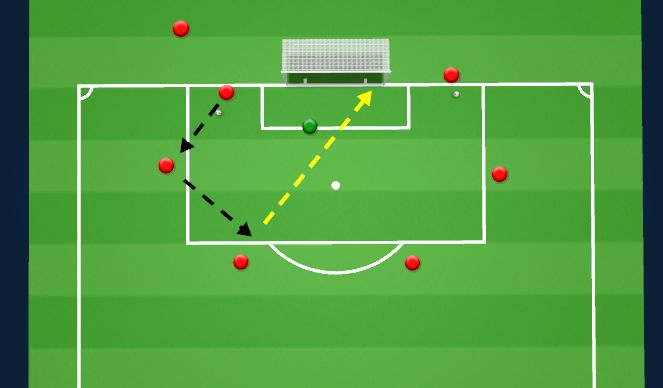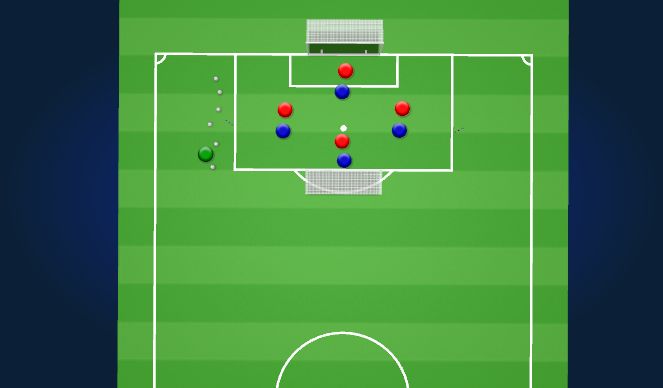Football/Soccer Session (Academy Sessions): FAW C Certificate Portfolio: Shooting Session - Session 1

Profile Summary

| Name: | Mark Elstob |
|---|---|
| City: | Treforest |
| Country: | United Kingdom |
| Membership: | Adult Member |
| Sport: | Football/Soccer |
Description
Session Overview
Number of players: 8
Equipment Required
Balls, Bibs, Cones, Flat Markers,
Area Size
As shown on the diagram (approx. 30x20), and will use the same area throughout for a smooth transition
0-15 minutes - Technical
15-35 minutes - Skill
35-60 minutes – SSG
Health And Safety Considerations
Size of Area - Kept as small as possible given our learners still developing physical aspects.Equipment used, such as flat cones, means the risk of tripping is minimised.
Mini Goals are used, and their portability ensures that we can move these away easily for the technicalpractice and then back into place for the Skill practice and SSG.
Learning Objectives
To be more accurate when shooting the ball.
Understanding where first touch needs to go in order to best position ourselves for a shot.
High volume ensures a lot of repetition and committing correct techniques to muscle memory.
Technical Coaching Points - FAW C Certificate "The Mechanics" Document fawcourses.com
Head and knee over the ball
Hips pointing the ball in the direction of travel
Vary Surfaces of the foot used to strike (inside, outside, laces)
Head Up
Lock Ankle when striking
Follow Through towards target
Coaching Toolbox
Technical Coaching Style
The autocratic approach used when discussing dribbling practices to enhance understanding and clarify expectations works best for a larger group of young learners. (Gill, 2015).
Skill Coaching Style
Democratic approach, coaches will need to stand back, assess performance and use questioning techniques to get players to think about their choices. (Gill, 2015)
SSG Coaching Style
"Laissez-faire" is defined in Gill's 2015 book "Foundations Of Sports Coaching" as a need for "Little input from the coach." - This would be the ideal. However, I accept that a Co-Operative approach, meaning the use of all four parts of the Coaching Styles Continuum, as outlined in the same text, would be appropriate depending on the context of how the session is going; the styles are as follows: Auto-Cratic, Co-Operative, Democratic, Laissez-faire, where Co-Operative is defined as operating at both ends of the spectrum.
Reference List
Ashley Gill (2015) Foundations of Sports Coaching : Second Edition. London: Routledge. pp. 49-50Available at: https://search.ebscohost.com/login.aspx?direct=true&db=nlebk&AN=882782&site=ehost-live(Accessed: 23 November 2024).
FAW, FAW C Certificate "The Mechanics". Available at: http://www.fawcourses.com (Accessed 23November 2024)
Owen, A., Twist, C. and Ford, P., 2004. Small-sided games: The physiological and technical effect of altering pitch size and player numbers. Insight, 7(2), pp.50-53.
See the guidance at the top of this page to understand why you are not seeing interactive Football/Soccer images.

Skill (20 mins)
The Practice - 15 Minutes
From the left-hand side, as we look, The ball is played halfway on the outside edge of the box. it is then passed to the top of the box, where the player, with a good open body shape, will take a touch and shoot with their right foot, aiming for the right-hand side of the net whilst also trying to beat a newly inserted goalkeeper to add an element of game realism and challenge.
The shooting player will then join the back of the queue to the right-hand side as we look.
The exercise will then repeat itself with players in that section, using their left foot for passing, receiving and then shooting on goal, this time aiming for the left-hand side as we look.
Players will work in 2 blocks of 2 minutes with a minute for a freeze to highlight any coaching points.
Challenges to be introduced in individual blocks, steadily bringing in: 1 touch finish, Near Post Finish, Top Corner Finishes.

See the guidance at the top of this page to understand why you are not seeing interactive Football/Soccer images.

SSG (25 mins)
Small Sided Game - 30 Minutes
2 Teams split equally (8 players will be used in this example, so 2 teams of 4), and goals will be age-appropriate size.
The first block will be completely free play, the objective of the game is to have as many shots on goal as possible. The design of the game is short and wide to facilitate this.
Players will work for a block of 3 minutes as free play and then progressions will be added in further every 3 minutes.
First Progression will see players take shots only with their right foot. - Any shots off target by Red or Blue will mean that the whole team need to sprint around the pole NEAREST TO them and get back into position before a ball is then played into the team that was defending.
Second Progression will see players take shots only with their left. - Any shots off target by Red or Blue will mean that the whole team needs to sprint around the pole FURTHEST AWAY them and get back into position before a ball is then played into the defending team.
The footedness rules will then be stripped away for the final work block. - Any shots off target by Red or Blue will mean that the whole team needs to sprint around the pole FURTHEST AWAY them and get back into position before a ball is then played into the defending team.
Teams will play in blocks of 5 minutes or coach will stop as appropriate to check energy levels.









 Play animation
Play animation Play step-by-step
Play step-by-step Repeat (toggle)
Repeat (toggle) Full Screen
Full Screen Pause
Pause Stop
Stop
Technical (15 mins)
The Practice - 15 Minutes
From the left-hand side, as we look, The ball is played halfway on the outside edge of the box. it is then passed to the top of the box, where the player, with a good open body shape, will take a touch and shoot with their right foot, aiming for the right-hand side of the net.
The shooting player will then join the back of the queue to the right-hand side as we look.
The exercise will then repeat itself with players in that section, using their left foot for passing, receiving and then shooting on goal, this time aiming for the left-hand side as we look.
Players will work in blocks of 2 minutes with a minute for a freeze to highlight any coaching points, gather up balls.
Challenges to be introduced in individual blocks, steadily bringing in: 1 touch finish, Near Post Finish, Top Corner Finishes.